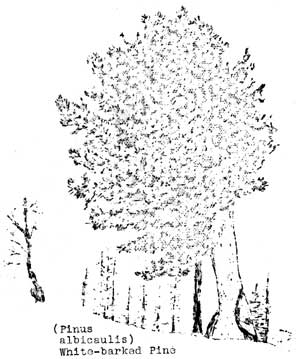
 | ||||||||
Mount Rainier is a single-mountain Park; a region surrounding a great, isolated volcanic cone whose upper slopes are covered with ice and snow throughout the year. The region, as a biological unit, is small containing about 378 square miles on and about the mountain. Although limited in area, there is a very great variation in habitat and plant distribution due to several factors, the most important of which is the change in altitude; the Park having all of the plant zones from sea level at this latitude to the Arctic. In this article the plants compared are from the same altitude, and the differences noted are due to other causes. The regions compared are the ones most often visited by the public, Paradise Park on the southwest slope, and Yakima Park on the northeast slope of the mountain. 
Yakima Park has a soil mainly of pumice and ash, wind-blown and devoid of much humus. This Park has few streams, a Xerophytic condition not found so widely distributed over Paradise Park which has a humus soil with much less ash and more streams. Paradise Park has a south exposure, Yakima Park a north exposure. Snow lies heavier on the south side, while the winds are more noticeable on the north side at Yakima Park. Yakima Park lies near the crest of the Cascade Range of mountains, and has received some species of plants, especially those of the dry-land type, that have come from the eastern slopes of the Cascades where there is much less moisture. Many of these have not reached the Paradise side because of the less favorable habitat on the southern slopes. The factors influencing plant distribution are complex. Following are some of the contributing causes to the differences in north and south side flora: One of the plants having a great peculiarity in distribution, and perhaps the Park's most conspicuous flower, is the Avalanche Lily (Erythronium montanum). This flower is entirely absent from Yakima Park. Its companion, the yellow Glacier lily (Ertythronium parviflorum) is quite common. Neighboring parklands, Summerland to the east and Berkely Park to the west both contain the Avalanche Lily. In Yakima Park, the soil condition is unfavorable to the growth of this plant. Another very noticeable difference is to be found in such flowers as Lyall's lupine (Lupinus lyallii), and the golden aster (Erigeron aureus) which are not common on the south side where they are found only at the higher elevations. In Yakima Park they are in great abundance and come down to much lower altitudes. The small crucifera, an alpine candytuft (Smelowskia ovalis), one of the highest growing plants on the mountain, comes down to 6000 feet in Yakima Park.
The dryland or Xeraphytic plants are found in abundance in Yakima Park. Phlox diffusa is, in the early season, the most abundant plant covering large areas. Along with the phlox, and protecting themselves from the lack of moisture in the same manner, are the Arenarias; four species, cespitosa, obtusiloba, capillaris, and verna. Both Phlox and Arenaria form a close cover over the ground, and have reduced leaves. Dryland grasses are scattered in abundance over Yakima Park. A beautiful, bush-like Potentilla (Dosiphora fruiticosa) is abundant here, but entirely lacking in Paradise Park. The trees also show interesting differences. The Engleman spruce (Picea englmanii) which is abundant on the north side is absent on the south. White-barked pine (Pinus albicaulis) which, in other parts of the Park grows only on the highest ridges - small and scrubby and very scattered - are found in great abundance all over Yakima Park and form beautiful groves of large, spreading, thrifty trees. The shrubs, Ceanothus, buck-brush, and others so common on the eastern slopes of the Cascades, are scattered over the northeastern flank of the mountain, but are nearly absent from the south side. The Cascade, or summit range, has also given to the northern and eastern sides of the mountain several Artemesias or sage-like plants of which Artemesia borealis wormskioldii is the most common. Near the Park boundary line at Tipsoo Lake is also found the beautiful delphinium (Delphinium bicolor), and in the same neighborhood on Chinook Creek is a beautiful monk's hood or Actonitum. There are several other very interesting plants found about Yakima Park which are either wanting or are very rare on the Paradise side. Anemone drummondi, a beautiful alpine anemone found only at the higher altitude is quite common. A red Sedum, one not hitherto reported as present in the Park, was found on Mount Fremont. Phacelia sericea, a violet colored waterleaf, found at St. Elmo's Pass and in the cracks and crevices of the cliffs of the same region, and a beautiful, large, single-flowered Potentilla (Potentilla villosa) with silvery, furry leaves were noted. Down in the forest depths dwells another floral beauty, Moneses uniflora, a common resident of the north side. While emphasis has been placed, in this article, on plants of the north side, there are many south side species that are entirely absent from the Yakima Park portions of Mount Rainier. Charles Landes,
| ||||||
| <<< Previous | > Cover < | Next >>> |
vol12-10b.htm
01-Mar-2002